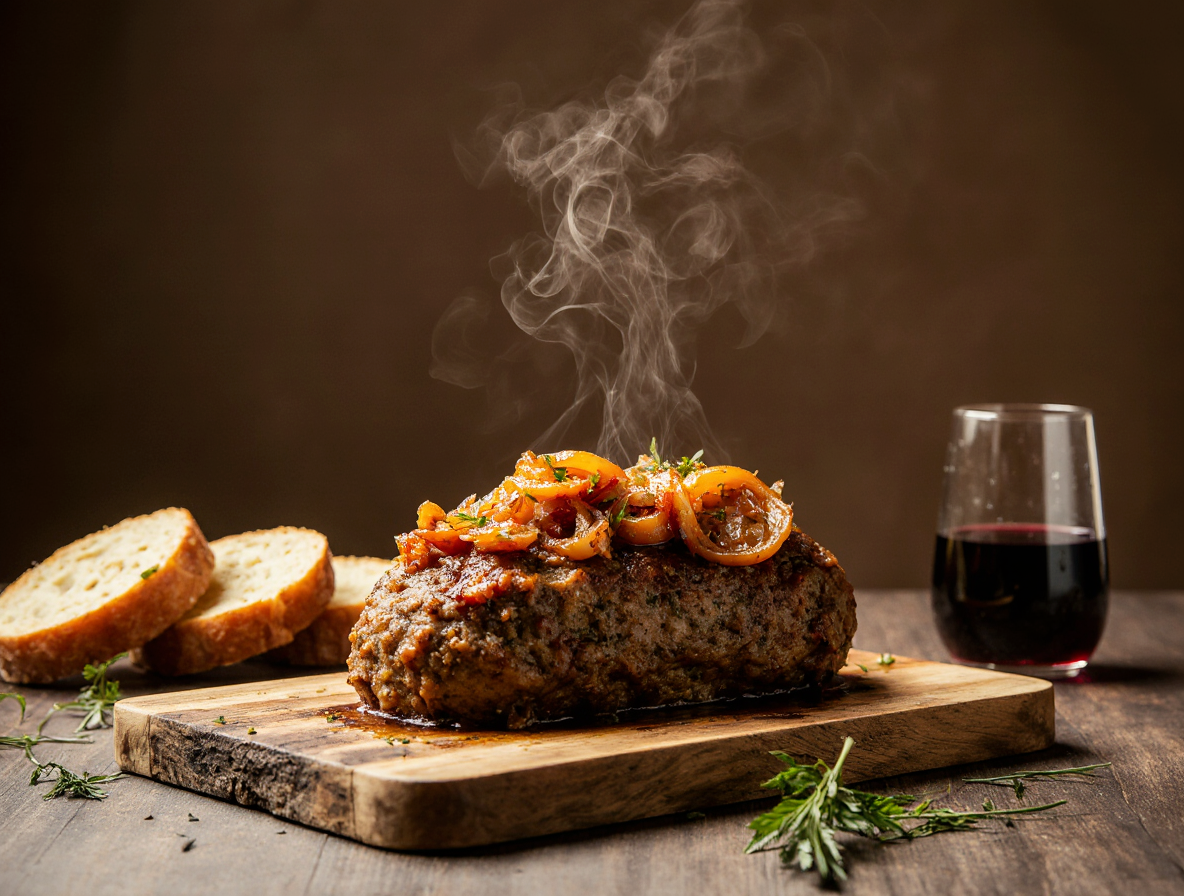How to Make French Onion Meatloaf: A Foolproof Guide for Perfect Results
Have you ever tasted a french onion meatloaf that’s so juicy and packed with flavor that it makes your taste buds dance? This incredible combination of caramelized onions, lean ground beef, and aromatic thyme creates a comfort food masterpiece that’s both impressive and satisfying.
Not only is this french onion meatloaf recipe perfect for feeding a crowd (it serves 12!), but it also offers impressive nutritional benefits when made with quality ingredients. In fact, choosing grass-fed beef can provide up to 5 times the amount of omega-3 fatty acids compared to conventionally raised beef. Whether you prefer using a french onion soup mix for convenience or fresh caramelized onions for that rich, slightly sweet flavor that permeates every bite, we’ve got you covered with foolproof instructions.
Additionally, what makes this recipe truly special is the golden-brown crust of bubbly Gruyère or Swiss cheese that melts perfectly over the top, giving you all the fancy French bistro feels without the extra work. The best part? If you happen to have any leftovers, they taste even better the next day, making this french onion soup meatloaf a meal prep champion.
In this guide, we’ll walk you through creating the best french onion meatloaf from start to finish, ensuring your meatloaf reaches the perfect internal temperature of 160°F for ideal doneness. Let’s get cooking!
Gathering the Right Ingredients
The success of your french onion meatloaf begins with selecting quality ingredients. Unlike other meatloaf recipes, this version requires specific components that create its signature savory flavor profile.
Choosing the best ground beef
For a truly juicy french onion meatloaf, opt for ground beef with an 80/20 lean-to-fat ratio. This balance ensures your meatloaf remains tender rather than dry. Nevertheless, if you prefer a leaner option, ground turkey makes an excellent substitute. Furthermore, many chefs recommend using a blend of meats—consider mixing beef with ground pork for enhanced texture and richness. Some recipes even suggest a 50-50 mix of lean grass-fed beef with fattier ground beef to maximize flavor.
Why Gruyère or Swiss cheese matters
The cheese selection dramatically impacts your french onion meatloaf’s character. Gruyère, a true Swiss native, offers a creamy, dense texture with a savory, nutty taste that intensifies with age. This makes it ideal for creating that authentic French bistro experience. Conversely, Swiss cheese provides a milder, slightly sweet flavor profile with its characteristic “eyes” or holes. While both melt beautifully, Gruyère holds its own in dishes calling for assertive flavor, whereas Swiss acts as more of a crowd-pleaser. Of course, in case neither is available, mozzarella or even sharp cheddar can work as substitutes.
Using French onion soup mix vs. fresh onions
You have two excellent paths to onion flavor glory. French onion soup mix offers convenience plus concentrated flavor in one packet. Meanwhile, fresh onions require caramelization—a process that transforms them into golden, sweet morsels that elevate your meatloaf. Although caramelizing takes time, a clever trick involves adding a pinch of baking soda to speed up browning. Many home cooks actually use both fresh caramelized onions and soup mix for maximum impact.
Optional add-ins for extra flavor
Consider these flavor-enhancing additions:
- Worcestershire sauce for umami depth
- Minced garlic cloves for aromatic complexity
- Breadcrumbs mixed with milk for moisture and binding
- A tablespoon of Dijon mustard for tanginess
- Smoked paprika or cayenne pepper for subtle heat
- Finely grated vegetables like zucchini or spinach (squeeze out moisture first)
Ultimately, gathering the right ingredients for your french onion meatloaf ensures each bite delivers that perfect balance of savory, cheesy goodness that makes this comfort food truly extraordinary.
Step-by-Step: Making the Meatloaf
Creating the perfect french onion meatloaf requires attention to detail at each step. The preparation process transforms simple ingredients into a comforting, flavor-packed dish that’s sure to impress.
Caramelizing the onions properly
The foundation of french onion meatloaf lies in properly caramelized onions. Heat a large, heavy-bottomed skillet over medium heat with butter or olive oil. Add thinly sliced onions and cook patiently for 25-30 minutes until they develop a deep golden-brown color. For those short on time, a clever shortcut involves adding a pinch of baking soda to your onions, which helps them brown faster and develop a softer texture. Throughout the process, stir occasionally to prevent burning, reducing heat if they’re browning too quickly. Properly caramelized onions should be sweet, soft, and richly colored—never rush this critical step.
Mixing the meatloaf base
Begin by placing breadcrumbs in a large bowl and pouring milk over them, allowing them to soak for a minute. Subsequently, add your caramelized onions (reserving some for garnish if desired), eggs, Worcestershire sauce, seasonings, and ground meat. Using your hands, gently combine the ingredients until just incorporated. This gentle touch is essential—overmixing leads to a tough, rubbery meatloaf. The mixture should come together without showing individual streaks, yet still maintain a tender texture.
Shaping and placing in the pan
You have two excellent options for shaping your french onion meatloaf. First, you can form the meat mixture directly in a loaf pan, patting it down gently. Alternatively, for a less greasy result, use the loaf pan only to mold the shape, then turn the formed meatloaf onto a parchment-lined baking sheet. This technique, popularized by Alton Brown, gives fat somewhere to drain and creates more surface area for browning. Some chefs even elevate the meatloaf on a cooling rack to keep it completely out of draining fat. Either way, ensure your loaf is evenly shaped for consistent cooking.
Baking and Finishing Touches
Once your french onion meatloaf is prepared and shaped, the proper baking techniques will ensure exceptional results. This final stage transforms your raw ingredients into a mouthwatering masterpiece.
How long to bake for perfect doneness
The ideal temperature for baking french onion meatloaf is 350°F, which prevents drying out yet thoroughly cooks the meat. Place your meatloaf in the middle position of your preheated oven and bake uncovered for 55-60 minutes. For absolute certainty, use an instant-read thermometer—the internal temperature must reach at least 160°F at the center. During baking, consider rotating your dish halfway through cooking if your oven heats unevenly. Remember that cooking times may vary slightly depending on your meatloaf’s size and shape.
Adding cheese and broiling for a golden top
Upon reaching the proper internal temperature, it’s time for the signature french onion meatloaf finishing touch. First, remove your meatloaf from the oven and switch to the broil setting. Sprinkle your reserved caramelized onions across the top, followed by a generous layer of Gruyère or Swiss cheese. Return to the oven and broil for approximately 2-3 minutes until the cheese becomes bubbly and golden brown. Watch carefully during this step—the difference between perfectly browned and burnt happens within seconds!
Making a simple onion sauce (optional)
For an extra flavor dimension, prepare an onion sauce while your meatloaf bakes. Combine remaining caramelized onions with beef broth in a skillet and simmer 5-7 minutes until thickened. Alternatively, create a creamy version by melting butter, adding grated onion, and incorporating flour to form a roux. Gradually whisk in milk until smooth, creating a velvety accompaniment. Let your finished meatloaf rest 10-15 minutes before slicing.
Serving, Storing, and Reheating
French onion meatloaf pairs beautifully with complementary sides that enhance its rich flavor profile. The meal becomes complete with thoughtful accompaniments.
Best sides to serve with French onion meatloaf
Mashed potatoes create the perfect foundation for soaking up delicious onion sauce. Consider goat cheese mashed potatoes for a tangy twist. Moreover, green vegetables provide balance—try roasted broccoli, air-fried Brussels sprouts, or honey-glazed carrots. Fresh bread options like Parker House rolls or garlic bread make excellent additions, particularly since they mirror traditional French onion soup presentation. For lighter meals, add a crisp romaine salad with tangy vinaigrette.
How to store leftovers safely
After completely cooling, place leftover meatloaf in airtight containers and refrigerate for 3-4 days. Alternatively, wrap tightly with plastic wrap. Notably, caramelized onions can be stored separately for up to 3 days.
Reheating tips to keep it moist
For oven reheating, preheat to 250°F, cover with foil, and heat until reaching 165°F internally. Consequently, this preserves moisture. Microwave slices beneath a damp paper towel in short intervals. Air fryer reheating takes just 5-10 minutes at 350°F.
Freezing instructions for meal prep
Cooked meatloaf freezes beautifully for up to 3 months. Wrap tightly in foil first, followed by plastic wrap. Unbaked meatloaf can be frozen for up to 3 months. Primarily, flash-freeze slices individually before packaging for convenient single servings.
Conclusion
French onion meatloaf stands as a true culinary achievement that brings together simple ingredients to create something extraordinary. Throughout this guide, we’ve explored how the perfect balance of caramelized onions, quality ground beef, and melted Gruyère creates a dish that satisfies both comfort food cravings and gourmet expectations.
Most importantly, this recipe offers remarkable flexibility. You can customize it with different meat blends, cheese options, or additional seasonings based on your preferences. The techniques we’ve shared—from properly caramelizing onions to achieving the ideal internal temperature—ensure your meatloaf will turn out perfectly every time.
Additionally, this dish proves itself as a practical choice for busy households. Leftovers taste even better the next day, and the freezing instructions allow you to prepare multiple meals at once. Therefore, you’ll save time without sacrificing flavor or quality.
Beyond its delicious taste, this french onion meatloaf delivers impressive nutritional benefits, especially when made with grass-fed beef. The combination of protein, vegetables, and careful preparation creates a satisfying meal that feels indulgent yet remains wholesome.
We hope this comprehensive guide inspires you to try this french onion meatloaf recipe. Whether you’re cooking for a family dinner or meal prepping for the week ahead, this dish will undoubtedly become a favorite in your recipe collection. Happy cooking!
FAQs
Q1. Should onions be cooked before adding them to meatloaf? Yes, it’s recommended to caramelize onions before adding them to meatloaf. This process enhances their flavor, making them sweet and tender, which complements the meat perfectly.
Q2. Can French fried onions be used in meatloaf? While not traditional, French fried onions can be used in meatloaf for added crunch and flavor. However, they’re best used as a topping or mixed in sparingly to avoid overwhelming the dish.
Q3. What ingredients should be avoided when making meatloaf? It’s best to avoid adding large chunks of raw vegetables like onions, garlic, or celery directly to meatloaf. These can remain crunchy and disrupt the desired texture. Instead, finely mince or pre-cook these ingredients.
Q4. What are some good side dishes for French onion meatloaf? Excellent sides for French onion meatloaf include mashed potatoes, roasted vegetables like broccoli or Brussels sprouts, and crusty bread. These complement the rich flavors of the meatloaf and provide a balanced meal.
Q5. How can I ensure my French onion meatloaf stays moist? To keep your meatloaf moist, use a mix of ground meats with some fat content, add milk-soaked breadcrumbs, and avoid overmixing the ingredients. Also, let the meatloaf rest for 10-15 minutes after cooking before slicing.


